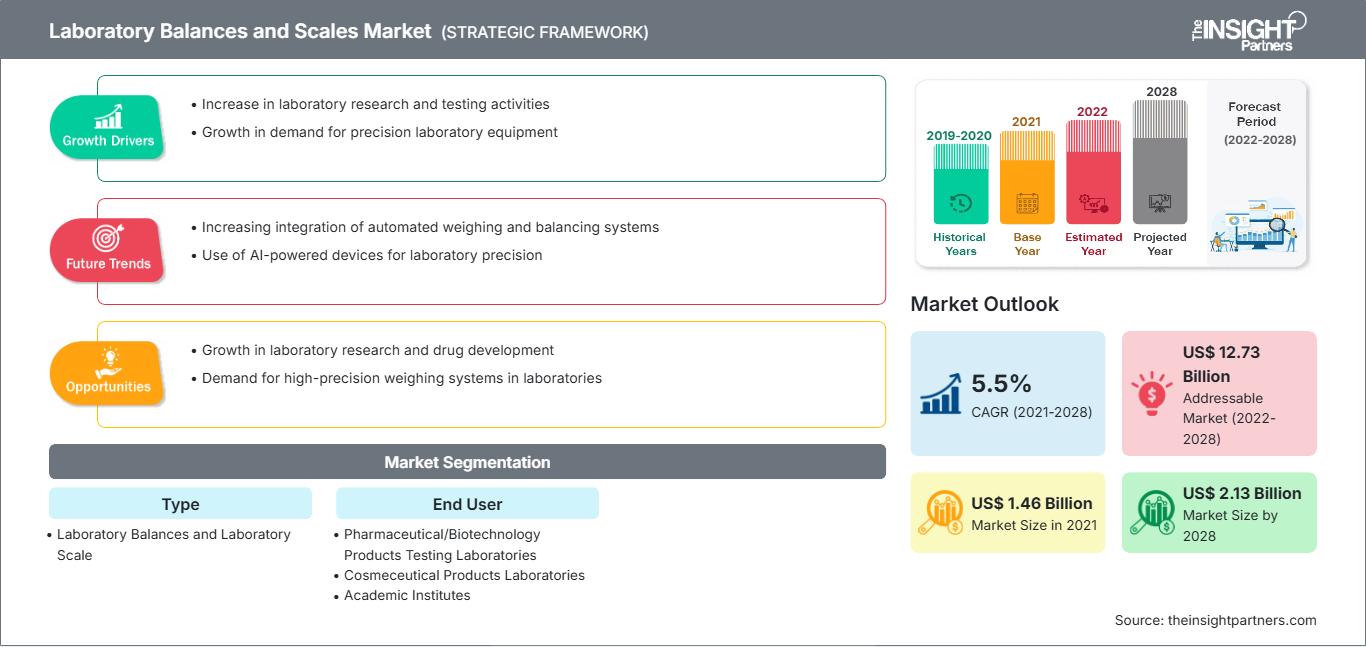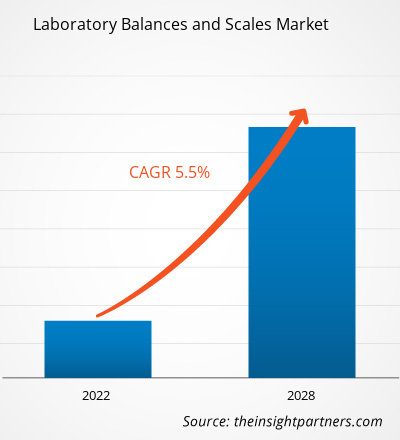Der Markt für Laborwaagen wird voraussichtlich von 1.463,53 Millionen US-Dollar im Jahr 2021 auf 2.131,14 Millionen US-Dollar im Jahr 2028 anwachsen. Das Marktwachstum wird von 2021 bis 2028 auf durchschnittlich 5,5 % pro Jahr geschätzt.
Der Markt für Laborwaagen umfasst Typ, Endverbraucher und Region. Er ist regional in Nordamerika, Europa, Asien-Pazifik, Naher Osten und Afrika sowie Süd- und Mittelamerika unterteilt. Der Bericht bietet Einblicke und eine detaillierte Analyse des Marktes für Laborwaagen und -waagen und legt dabei den Schwerpunkt auf verschiedene Parameter wie Markttrends, technologische Fortschritte, Marktdynamik und eine Wettbewerbsanalyse führender Marktteilnehmer weltweit. Er enthält außerdem eine Analyse der Auswirkungen von COVID-19 auf alle Regionen.
Passen Sie diesen Bericht Ihren Anforderungen an
Sie erhalten kostenlos Anpassungen an jedem Bericht, einschließlich Teilen dieses Berichts oder einer Analyse auf Länderebene, eines Excel-Datenpakets sowie tolle Angebote und Rabatte für Start-ups und Universitäten.
Markt für Laborwaagen: Strategische Einblicke

-
Holen Sie sich die wichtigsten Markttrends aus diesem Bericht.Dieses KOSTENLOSE Beispiel umfasst Datenanalysen, die von Markttrends bis hin zu Schätzungen und Prognosen reichen.
Die Gesundheitsinfrastruktur erlebt weltweit ein starkes Wachstum der Anzahl klinischer Studien und Forschungspipelines. Klinische Studien sind ein entscheidender und wichtiger Schritt, um die Sicherheit und Wirksamkeit einer medizinischen Strategie, Behandlung oder eines Geräts für die kommerzielle Nutzung zu bewerten. Diese Studien helfen auch, die besten medizinischen Ansätze für ein bestimmtes Therapiegebiet zu verstehen und zu bestimmen. Klinische Studien werden in erster Linie durchgeführt, um Daten zur Sicherheit und Wirksamkeit der Entwicklung neuer Medikamente und Geräte zu sammeln. Vor der Zulassung von Arzneimittelmolekülen oder Medizinprodukten durch die Aufsichtsbehörden werden eine Reihe klinischer Studien durchgeführt.
Anzahl der registrierten Studien für klinische Studien|
Erste Veröffentlichung im Jahr |
Studien zu Jahresbeginn |
Studien im Jahresverlauf |
Studien am Ende Jahr |
|
2015 |
181.304 |
24.130 |
205.434 |
|
2016 |
205.434 |
27.809 |
233.243 |
|
2017 |
233.243 |
29.198 |
262.441 |
|
2018 |
262.441 |
17.836 |
280.277 |
|
2019 |
293.275 |
32.519 |
325.794 |
|
2020 |
325.794 |
36.740 |
362.534 |
Quelle: Clinical Trials.gov und The Insight Partners Analysis
Die steigende Zahl klinischer Studien beschleunigt die Nachfrage nach Laborinstrumenten und -geräten, was letztendlich den Markt für Laborwaagen im Prognosezeitraum ankurbeln wird.
Typbasierte Einblicke
Der Markt für Laborwaagen ist nach Typ in Laborwaagen und Laborwaagen unterteilt. Das Segment Laborwaagen ist weiter unterteilt in Analysenwaagen, Toplader-/Präzisionswaagen, Mikro- und Ultramikrowaagen, Feuchtewaagen, tragbare Waagen und sonstige Waagen. Das Segment Laborwaagen ist außerdem weiter unterteilt in Tischwaagen, Zählwaagen, Kompaktwaagen und sonstige Waagen. Das Segment Laborwaagen hatte 2021 den größten Marktanteil und wird im Prognosezeitraum voraussichtlich die höchste durchschnittliche jährliche Wachstumsrate (CAGR) von 5,8 % verzeichnen.
Laborwaagen
Regionale Einblicke in den Markt für LaborwaagenDie Analysten von The Insight Partners haben die regionalen Trends und Faktoren, die den Markt für Laborwaagen im Prognosezeitraum beeinflussen, ausführlich erläutert. In diesem Abschnitt werden auch die Marktsegmente und die geografische Lage in Nordamerika, Europa, dem asiatisch-pazifischen Raum, dem Nahen Osten und Afrika sowie Süd- und Mittelamerika erörtert.
Umfang des Marktberichts zu Laborwaagen
| Berichtsattribut | Einzelheiten |
|---|---|
| Marktgröße in 2021 | US$ 1.46 Billion |
| Marktgröße nach 2028 | US$ 2.13 Billion |
| Globale CAGR (2021 - 2028) | 5.5% |
| Historische Daten | 2019-2020 |
| Prognosezeitraum | 2022-2028 |
| Abgedeckte Segmente |
By Typ
|
| Abgedeckte Regionen und Länder |
Nordamerika
|
| Marktführer und wichtige Unternehmensprofile |
|
Dichte der Marktteilnehmer für Laborwaagen und -waagen: Verständnis ihrer Auswirkungen auf die Geschäftsdynamik
Der Markt für Laborwaagen wächst rasant. Die steigende Nachfrage der Endverbraucher ist auf Faktoren wie veränderte Verbraucherpräferenzen, technologische Fortschritte und ein stärkeres Bewusstsein für die Produktvorteile zurückzuführen. Mit der steigenden Nachfrage erweitern Unternehmen ihr Angebot, entwickeln Innovationen, um den Bedürfnissen der Verbraucher gerecht zu werden, und nutzen neue Trends, was das Marktwachstum weiter ankurbelt.

- Holen Sie sich die Markt für Laborwaagen Übersicht der wichtigsten Akteure
Der Markt für Laborwaagen und -waagen wird laut Indikation von Prüflaboren für pharmazeutische und biotechnologische Produkte, Laboren für kosmetische Produkte, akademischen Instituten und Forschungslaboren genutzt. Die Prüflabore für pharmazeutische und biotechnologische Produkte hatten 2020 den größten Marktanteil, und für dasselbe Segment wird im Prognosezeitraum die höchste durchschnittliche jährliche Wachstumsrate (CAGR) von 6,7 % erwartet.
Unternehmen setzen häufig auf anorganische Strategien wie Partnerschaften sowie Fusionen und Übernahmen, um der sich ändernden Kundennachfrage gerecht zu werden und ihren Markennamen weltweit zu behaupten. Marktteilnehmer, die auf dem Markt für Laborwaagen und -waagen tätig sind, verfolgen auch organische Strategien wie Produkteinführungen und -erweiterungen, um ihre Präsenz und ihr Produktportfolio weltweit zu erweitern und die wachsende Nachfrage zu befriedigen.
Nach Typ
- Laborwaagen
- Analysewaagen
- Toplader-/Präzisionswaagen
- Mikro- und Ultramikrowaagen
- Feuchtigkeitswaagen
- Tragbare Waagen
- Sonstige Waagen
- Laborwaagen
- Tischwaagen
- Zählwaagen
- Kompaktwaagen
- Sonstige Waagen
Nach Endbenutzer
- Prüflabore für pharmazeutische und biotechnologische Produkte
- Labore für kosmetische Produkte
- Akademische Institute
- Forschungslabore
Nach Geografie
- Nordamerika
- USA
- Kanada
- Mexiko
- Europa
- Frankreich
- Deutschland
- Italien
- Großbritannien
- Spanien
- Restliches Europa
- Asien-Pazifik (APAC)
- China
- Indien
- Südkorea
- Japan
- Australien
- Restliches APAC
- Naher Osten & Afrika (MEA)
- Südafrika
- Saudi-Arabien
- VAE
- Rest von MEA
- Süd- und Mittelamerika (SCAM)
- Brasilien
- Argentinien
- Rest von SCAM
Firmenprofile
- METTLER TOLEDO
- Sartorius AG
- PCE Instruments
- OHAUS
- Adam Equipment Ltd
- GRAM PRECISION
- RADWAG Balances and Scales
- Scientech Inc.
- BONSO Electronics International Inc.
- A&D Company, Limited
- Historische Analyse (2 Jahre), Basisjahr, Prognose (7 Jahre) mit CAGR
- PEST- und SWOT-Analyse
- Marktgröße Wert/Volumen – Global, Regional, Land
- Branchen- und Wettbewerbslandschaft
- Excel-Datensatz
Aktuelle Berichte
Erfahrungsberichte
Grund zum Kauf
- Fundierte Entscheidungsfindung
- Marktdynamik verstehen
- Wettbewerbsanalyse
- Kundeneinblicke
- Marktprognosen
- Risikominimierung
- Strategische Planung
- Investitionsbegründung
- Identifizierung neuer Märkte
- Verbesserung von Marketingstrategien
- Steigerung der Betriebseffizienz
- Anpassung an regulatorische Trends






















 Kostenlose Probe anfordern für - Markt für Laborwaagen
Kostenlose Probe anfordern für - Markt für Laborwaagen